EDITOR’S NOTE (4/26/23): Please note that Polymer Varnish has been discontinued and replaced with Gloss Waterborne Varnish. You can read more about it here.
If you are working with mixed media, the best display solution is usually behind UV-protective glass. This provides ultimate protection against UV-light, dirt and dust. If you decide against mounting behind glass, then varnishing or top coating can be the next best option, however, that can become tricky when mixed media pieces contain sensitive materials. Varnishing almost always introduces visual changes to artworks and depending on the materials, these changes can be permanent. Thus, the first question is, whether it is worthwhile to take that risk. Our video “Should you Varnish your Painting?” and JP article “Tips and Tricks for Varnishing” deal with this question.
When varnishing mixed media pieces it is important to be aware of the properties and sensitivities of each material present in the artwork. The most sensitive material in the piece usually dictates if, how (brush or spray) and with which varnish, fixative, or topcoat the artwork can be coated. If unsure, each material in the artwork should be tested for sensitivity on a sacrificial test piece. Additionally, some materials do not accept varnishes and no suitable coating would adhere to these. What follows is a list of materials that are frequently used in mixed media and things to consider when wishing to varnish these materials.
Oil & Wax Pastels

Oil pastels are made with non-drying oils and wax, which means they never dry or cure. This can be a great feature as they remain workable indefinitely, but it makes varnishing pretty much impossible as subsequent coatings do not adhere on these pastels permanently. Image 1 shows detail of a wax crayon painting that was completely painted over in oil. The oil layers seemed to adhere at first, but several years later, cracked open and delaminated. Although we have no long-term testing of GOLDEN Varnishes over oil and wax pastels, we would expect similar results and do not recommend varnishing these materials at all.
Artists who wish to use a varnish or fixative on their oil pastels despite the risk of future delamination will likely encounter a second problem, namely tackiness. Especially softer oil pastels remain tacky, also when varnished. In our testing we found that GOLDEN Archival Varnish Gloss remains very tacky over some oil pastels, also when applied as a second coating over various fixatives. Fixatives contain significantly less binder than a varnish and therefore might perform better on these pastels in terms of tackiness. Of the Sennelier Oil Pastel Fixative and the Lascaux Fixative, the Sennelier product gave the best results, with the oil pastel remaining tacky only ever so slightly. However, product formulations can always change without notice and testing remains essential.
⇒ Oil and wax pastels do not cure and are best shown behind glass. We do not recommend varnishing, but if varnishing is attempted, follow manufacturer’s recommendations for sealants and fixatives.
Graphite Pencil
Everybody is familiar with graphite pencils. But who knew that graphite is also a so-called ‘dry lubricant’? Graphite is often used to lubricate valves, locks, joints, ball bearings, etc. As one can imagine, adhesion of any coating on a lubricant isn’t great. Now, pencils consist not only of graphite. The lead of a pencil contains graphite as pigment, clay as binder and grease and wax as impregnating agent, which also allows for smoother abrasion and better writing ability of the pencil. The higher the clay content, the harder the pencil. So, if harder pencils contain more clay, is it easier to varnish those? We carried out adhesion tests on pencil marks made with pencils (by Faber-Castell) of various hardness, on canvas board that was painted with Fluid Matte Cerulean Blue. We found that after 2 weeks of drying time GOLDEN Varnishes had good adhesion on soft and on hard pencil marks, while the Isolation Coat indeed had better adhesion on harder pencils (Image 3). When we tested the varnishes and the Isolation Coat after only 4 days (Image 4), there were failures on soft as well as on hard pencils. However, the solvent based MSA and Archival Varnishes performed significantly better compared to the water based Isolation Coat and the Polymer Varnish.
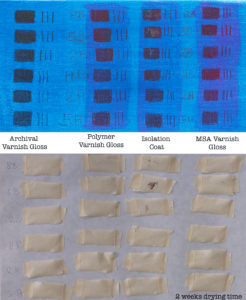
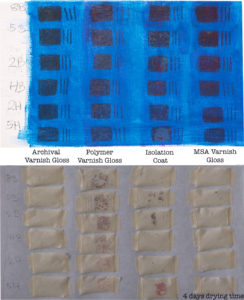
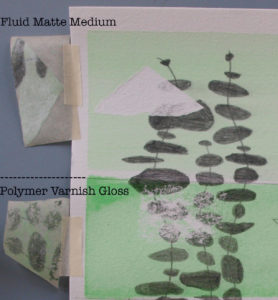
On paper the story was quite different (Image 5). Varnished pencil on paper had such good adhesion that the tape used in the testing tore the paper. Thus, the bond of the varnish to the pencil was stronger than the internal paper bond.
Harder pencils also resist smearing and bleeding better when brush- coated with wet acrylic product. We found that 2B or harder pencils can be brushed over with Polymer Varnish, for instance, without lifting the graphite (Image 6). However, we only tested one brand of pencil, namely Faber-Castell, and results may vary with other brands. When brush varnishing graphite drawings, which consist only of a few lines, it can help to apply an acrylic medium on top of the drawing first, thereby following the graphite line closely. Alternatively, using the smearing to create shadows or shading could be used as a technique.

For some artists, who love the look of graphite in their mixed media works, GOLDEN Graphite Gray (#1160) might be a viable alternative. The product is highlighted here.
⇒ Graphite is a dry lubricant and adhesion of subsequent coatings tends to be poor. For artworks with large and thick areas of graphite, we recommend not to varnish at all. In our testing, the adhesion of GOLDEN Varnishes improved considerably after about 2 weeks of drying. Since graphite is water soluble, the MSA and Archival Varnishes may be the better option, since they are less likely to smear and tend to adhere better to graphite than the water based Isolation Coat and Polymer Varnish.
Charcoal, Crayons & Soft Pastels
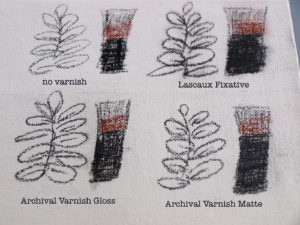
When varnishing dry media, the main issue is usually the change in appearance, that can affect color saturation, color value, surface sheen and the general character of the surface (Image 7). There is a fine line between barely fixing the drawing and saturating it to the extent that the pigments are actually surrounded in varnish and thus secured to the substrate. Fixatives are not meant to protect or encapsulate the media completely, only to prevent some of the lifting, which is why they are usually called “workable”. If the fixative is very thin, pigments can still lift when the surface is rubbed, but the appearance of the dry mark is preserved better. How sensitive charcoal and soft pastels is demonstrated here. Therefore, spraying may be the best possibility to apply varnish so that mechanical action on these surfaces is avoided. Some artists prefer Matte Varnishes to truly protect their drawing and preserve a little of the matte sheen, natural to charcoal, soft pastels and similar media.
⇒ Light spraying of mediums or varnishes act more like fixatives and drawings can remain prone to pigment lifting, but retain more of their dry media character. Heavier coats of varnish provide better protection, but can cause more change in color values, saturation and surface sheen.
Colored Pencil
Colored pencils are wax or oil based, which makes long term adhesion of subsequent varnishes and topcoats problematic. The oil and wax content also makes them sensitive to many organic solvents that are common in varnishes. In addition, colored pencils also contain additives such as thickeners, preservatives, humectants, and surfactants, whereby especially the latter can make them sensitive to water. Additionally, water borne acrylic products also require surfactants in their formulations and so are more likely to smear out a colored pencil drawing when it’s brush-coated with Polymer Varnish, for example. At the same time we know, however, that many artists use our acrylic mediums over colored pencils successfully and testing on a case by case basis would be necessary. Results can vary because there are many different types of colored pencils out there. Due to this variability we would consider this application experimental.
We have not done extensive adhesion tests of our varnishes on colored pencils and only sampled the adhesion of Archival Varnish Gloss on the oil based artist pencil by Faber-Castell and wax based pencil by Staedtler, which proved excellent after 2 weeks of drying.
⇒ We do not recommend our varnishes over wax or oil based colored pencils, due to potential adhesion problems in the long run. For those who still want to varnish or topcoat colored pencils we would recommend to test first and check pencil manufacturers’ recommendations.
Pens & Markers
The variety in markers available to artists is tremendous so that case by case testing for potential sensitivities is unavoidable. Pens and markers can bleed when spray varnished and smear when brushed over. One might think that a permanent pen could be brushed over with a water based varnish and a pigmented (vs. ink) pen could be coated with a solvent based varnish without bleeding. We tested some twenty pens and markers and found:
- One really needs to test!
- Permanent pens and markers, whether ink or pigment-based, can smear and bleed significantly when coated with water based Polymer Varnish or Isolation Coat. We had similar results when testing alcohol inks with GOLDEN Acrylics and Varnishes.
- On paper substrates the Archival Varnish (and other solvent based varnishes and fixatives) can saturate the paper and cause ink to become very visible on the reverse of the paper, which is more relevant when varnishing works in sketch books where both sides of a paper contain artwork.
- Most artist-quality pens and markers that we tested did not bleed when sprayed with Archival Varnish but there can be a slight color shift in ink-based markers.
The label ‘permanent’ on markers also often leads to misunderstanding. On pens, like Sharpies for instance, this label refers to the fact that the pen marks are permanent on wearables when laundered or put in a dryer. It does not mean that these markers are lightfast, not even when varnished.
⇒ Artist-quality pens and markers tend to be least problematic when varnishing, but testing remains essential.
Watercolors
We have two articles on varnishing watercolors, which really help to understand what kind of changes a watercolor can undergo through varnishing. The bottom line is, young watercolor paintings are sensitive to aqueous mediums and varnishes and therefore are best spray varnished. See: Aesthetics of Varnishing Transparent Watercolor and Aesthetics of Varnishing Transparent Watercolor: Creating the Least Change.
Papers and Prints
Decorative craft papers or prints are often used in collages and varnishing these can be an option, if the paper elements are in any way covered with acrylic medium or paint. However, if that is not the case, varnishing could significantly change the appearance of the paper, by saturating or darkening its color, changing gloss, or texture (Image 8). If using MSA or Archival Varnish directly on thin papers like rice paper or magazines, this could also cause the paper to become transparent and in the case of magazines and newspaper, one would then be able to see the print on the other side through the front.
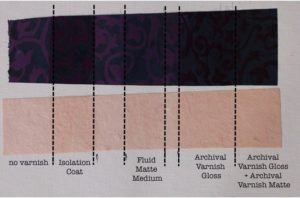
As a general rule water and ammonia sensitivity tends to be less of a concern with laser jet prints than with inkjet prints and photographs, although toners are continuously changing and it seems that inkjet prints are less water sensitive now than they were in the past. We do not recommend any of our products on actual photographs (traditional photographic emulsion developed from films), since they would be destroyed by a water or solvent based product and which is why photographers always frame under glass. We just don’t want anyone to chance destroying their precious photographs. We have also seen some solvent sensitivity with traditional dye sublimation photos, which can result in bleeding, blurring and color changes. Here you will find great tips on coating inkjet prints and this article describes lightfastness testing of pigment and dye-based inks. We found that Archival Varnish w/UVLS and MSA Varnish w/UVLS, as well as a handful of other brands which are named in the article, protect prints significantly against fading. Testing your products would always be recommended.
⇒ The saturation of decorative papers can cause significant color shifts towards darker values and previous testing is required to determine whether these changes are acceptable. Nowadays there is a lot of variability with the many types of prints and these products are moving targets. Therefore, individual testing of the products is necessary.
Conclusion
Once it has been established which material of a mixed media piece is the most sensitive, the appropriate varnish and application method can be tested and applied. If however, collage materials have sensitivities that would require contradicting approaches, then it might be an option to varnish certain materials before applying them to the collage or applying unvarnished materials onto a varnished mixed media piece. This certainly requires that one thinks about varnishing during the creative process. We would consider such layering experimental, since applying more artwork over removable varnishes always puts these top layers at risk of being inadvertently removed during a future varnish removal. In such a case we would also recommend applying a note on the reverse of the artwork, which indicates how the various elements have been varnished.
Further Reading
More information on varnishing can be found in our Varnishing Resources.
Further reading on materials:
Waterproof India Inks and Shellac-based Primers
Using Alcohol Inks with GOLDEN Acrylics and Varnishes
Why Oil Painting Over MSA or Archival Varnish Is Not Recommended
Categories of Wax-Based Drawing Media
About Mirjam Auf der Mauer
View all posts by Mirjam Auf der Mauer -->Subscribe
Subscribe to the newsletter today!
No related Post

I had recently observed through the Winsor & Newton Page The application of a conservator varnish over a finished charcoal surface–I believe using it as a spray fixative. This was applied over the course of the demonstrations several times building up a darker tone–with no lift. What is your feelings about this?
Hello Dillard, thank you for your comment. Yes, it is certainly possible to apply multiple layers of fixative over dry media paintings and as you observed this can darken these paintings or saturate colors. It solely depends on the artist, whether these visual changes are acceptable to him/her. The advantage, when truly embedding charcoal like that in many layers of fixative is, that the drawing becomes resistant to color lift and it might be possible to show the work without being framed behind glass.
Hello Mirjam,
I am working with mixed media on multmedia board, prismacolor pencil on top of acrylic or sometime water soluble oil ground. Then sometimes I add surface layer of prismalcolor NuPastel (a hard chalk pastel). I then seal with many layers of archival fixative and then archival spray varnish. Do you know if I still need to protect with glass? I like to avoid glass if possible. Thanks!
Hello Ann Michelle,
we have found that 6 spray coats of GOLDEN Archival Spray Varnish provides good UV-protection, similar to two brush applied coats of MSA Varnish w/UVLS. Therefore it shouldn’t be necessary to protect behind UV-glass in addition, which is also costly. Regular window glass only provides very limited UV-protection anyway.
I am confused. Fixative is acrylic correct? How can you apply a fixative over products/mediums that contain wax or oil and not expect it to crack. She mentions applying a wax medium over an acrylic and sometimes over a waterbased oil ground. She also applies several coats of a spray varnish. Does she think this is archival because she is using archival sprays? How can this be permanent? Does a waterbased oil ground contain oil? I am curious.
Hello Donna, thank you for your comments. Many fixatives are acrylic based, but other types of resins can also be used. Our Archival Varnish is acrylic. The acrylic in the varnish is not made into a waterborne dispersion, like with our acrylic paints, but is diluted in solvent. This allows the acrylic varnish to be compatible over oil paints. That’s also why we call it MSA Varnish – mineral spirit acrylic varnish. The Archival Varnish is the aerosol version of the MSA Varnish.
We hope this helps. Let us know if there’s anything else we might help with.
Mirjam
This answers one part of my question but not why she would varnish over wax!
Varnishing has several benefits, also over mixed media artworks that contain wax. A varnish evens out the surface sheen and saturates colors. It can also provide UV-protection, if the varnish contains UV-light stabilizers. Varnished artworks can also be easier to clean or dust.
It’s 2023! But maybe you will see this. I have recently been painting with acrylics and have looked at YouTube videos since I’m unfamiliar with some technical aspects. Following the lead of some professional artists online, I have done canvases where I laid down areas of acrylics, then done scribbling with Sennelier oil pastels, then gone back in with more acrylics on top covering pastel areas with paint and leaving some visible.
I was planning to use liquitex satin varnish over the paintings at the end, assuming it will all work.
Now I am panicking! Can you advise? I have a solo show coming up in a month so time is of the essence. I can supply images is you like. Thank you!! Btw canvases are very thick, cannot use glass to cover
Hello Christine,
Thank you for your question. Oil Pastels generally contain non-drying oils and waxes, both of which might cause adhesion issues when acrylics are brushed over the top. We do not have any products we would recommend over oil pastel. However, Sennelier does have a fixative intended for oil pastels which might work as a final layer: D’Artigny Pastel Fixative. It would be good to confirm with Sennelier that it can be applied over acrylics and on flexible surfaces. You might keep in mind, too, that most artists do not varnish their paintings.
Warm regards, Cathy
Hi,
I have just started using Acrylic Ink in my mixed media /collages. Usually, I apply an isolation coat (Gel Medium w/ water) over the entire piece. Sometimes I add a varnish on top of this, Is this possible with acrylic ink?
Hello Paula, Acrylic Inks are typically thin viscosity or water-like acrylic paints. So you could apply an Isolation Coat to them is you wanted to varnish. You could always test on the side to see if there is any color lift, but we suspect it should be fine. Let us know if you have other questions. [email protected]
Hello,
I was hoping you might be able to help me out with a query if you get a spare minute.
I’ve been playing around with Sennelier Oil pastels and oil bars over the past few months, working them into layers of wet oil paint.
I’m curious about drying times of the oil pastel, well, more curious about fixing the oil pastel once it’s off gassed as I know that the pastel doesn’t seem to ever fully dry due to the oils and waxes.
I’ve been working on primed and gessoed linen so I don’t really want to frame them behind glass, so I’m trying to find a way around it.
I see from a previous comment that the Sennelier oil pastel fixative was mentioned.
My query is do you think it would be possible to present oil pastel and oil paint on gessoed linen with out framing them behind glass by fixing the surface with Sennelier fixative then sealing with Golden archival varnish?
It’s very specific…I know!🙄😂
Best,
Alan
Hello Alan,
Thank you for your question. We have not tested our Archival Varnish over the Sennelier Oil Pastel fixative, so cannot comment on their compatibility. It is possible that the mineral spirits in the Archival Varnish would penetrate through the fixative, and cause the oil pastel to react in some way if it is solvent sensitive. There is also the issue of having a non-drying layer under a dry layer: that oil pastel will always be squishy, and if pressed upon might move even with varnish on top. The varnish in those areas also will not be fully adhered to the artwork.
We would suggest creating some test pieces of oil pastels, and then applying the fixative followed by the varnish. This is a good way to make sure that the products are all compatible, and the varnish will dry as it should when applied over this experimental layering of materials. Once the varnish is dry, check what happens if areas over the oil pastel are pressed upon, and check what happens if tape sticks to the varnish over those areas. You can then decide if the results are acceptable. Also, please keep in mind that we recommend allowing oil paint to dry for at least 6-12 months before varnishing.
We wish we had a definite solution for you, and hope this is at least a little helpful.
Warm Regards,
Cathy
Hello Alan,
Thank you for your question. We have not done much testing with oil pastels, but they are art materials which often do not dry completely due to the materials they contain. The Sennelier website describes their oil pastels as containing an “inert, non-drying binder.” You might contact Sennelier for more information on these products. We believe their D’Artigny Pastel Fixative is crafted to provide their oil pastels with a more durable surface. Again, you might contact Sennelier to see how many coats would be needed to display safely without glass (or do some testing!). We do not think putting Golden’s Archival Varnish over the fixative would be needed. Since the Archival Varnish contains solvents, there might also be issues with this layering of products. If you wish to explore, we would recommend testing first on a sacrificial oil pastel surface. We hope this is helpful, and we wish you happy creating!